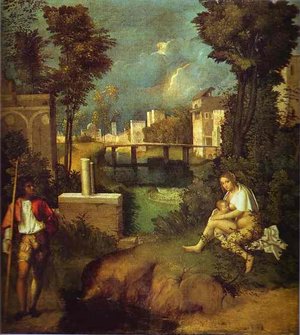Giorgione
|
|
Giorgione (c. 1477-1510) is the familiar name of Giorgio Barbarelli da Castelfranco, a Venetian artist who was one of the most important figures in the Venetian High Renaissance. Giorgione is known for the elusive poetic quality of his work, and for the fact only a very few (around six) paintings are known for certain to be his work. At his sudden death from plague he probably left some works unfinished, which may have been completed by his colleagues Titian or Sebastiano del Piombo. The resulting uncertainty about the identity and meaning of his art has made Giorgione the most mysterious figure in Western painting.
Giorgione came from the small town of Castelfranco Veneto, outside of Venice. His name is sometimes spelled Zorzo. The variant 'Giorgione' or 'Zorzon' means 'big George'.
While still in Castelfranco he painted the Castelfranco Madonna, a fairly conventional image of the Madonna enthroned, with saints on either side (a sacra conversazione painting). However, it marks a departure in Venetian art, with its curiously introverted saints and its delicate color modulations. This is painted with the tiny disconnected spots of color that Giorgione brought into oil painting, derived from manuscript illumination techniques. These gave Giorgione's works the 'magical' glow of light for which they were famous.
However it is works such as the Three Philosophers and The Tempest that are most famous. The meaning of these paintings is mysterious, though art historians have attempted to ascribe conventional subjects to them, they remain strange. The first depicts three figures near a dark empty cave. There seem to be suggestions of Plato's cave and of the three Magi, but it remains unclear. The same is true of The Tempest in which a soldier on one side of a stream and a breast-feeding woman on the other side seem to be awaiting a storm.
His portraits were the first to be painted in the "modern manner", and are full of dignity, truth of characterization, simplicity, and a silvery quality unsurpassed even by Velazquez. The precocious and versatile young man was the first to paint landscapes with figures, the first to paint genre movable pictures in their own frames with no devotional, allegorical, or historical purpose and the first whose colours possessed that ardent, glowing, and melting intensity which was so soon to typify the work of all the Venetian School. Giorgione was the first to discard detail and substitute breadth and boldness in the treatment of nature and architecture; and he was the first to recognize that the painter's chief aim is decorative effect. He never subordinated line and colour to architecture, nor an artistic effect to a sentimental presentation.
His life was described in Giorgio Vasari's Vite.
See also:
eo:Giorgione fr:Giorgione it:Giorgione nl:Giorgione ja:ジョルジョーネ pl:Giorgione sv:Giorgione

